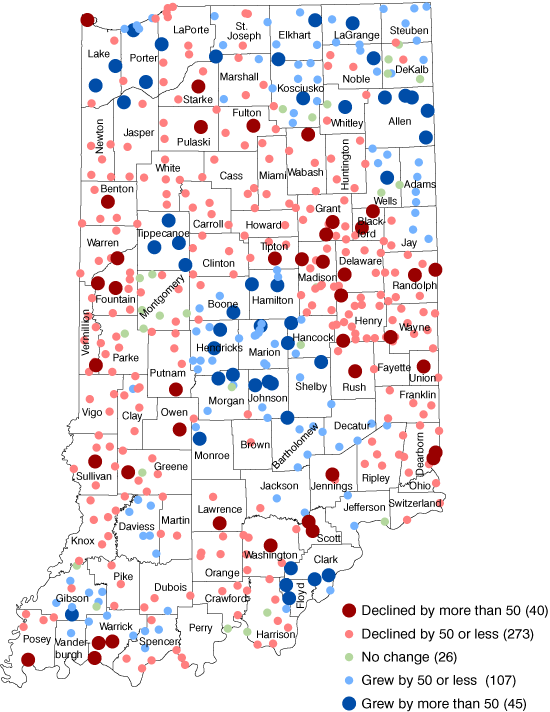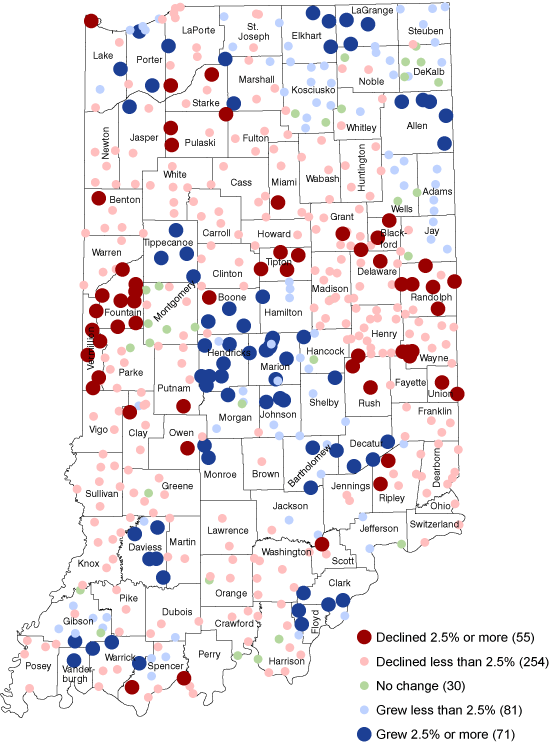Growth and Decline in Indiana's Small Towns
Since 2010, 31 percent of Indiana’s small cities and towns (those with fewer than 10,000 residents) have experienced population increases. For comparison, however, 66 percent of cities and towns with more than 10,000 people have grown.
Indiana had 491 cities and towns with fewer than 10,000 residents (we will refer to these places as “small towns” for convenience) at the time of the 2010 Census.1 Combined, these small towns were home to more than 830,000 people in 2014, based on the annual population estimates from the U.S. Census Bureau. This equates to 13 percent of the state’s population, exceeding the percentage of people who live in small towns nationwide (9 percent).2
More Hoosiers live in Indiana’s small towns now than in 2010, but small town growth has not kept pace with other areas. At 0.6 percent, Indiana’s small towns have grown slower in recent years than the state’s larger cities and towns (2.3 percent growth) and unincorporated areas (1.0 percent growth), as shown in Table 1.
Table 1: Indiana Population Changes
| Name | 2014 Population | Percent of Total Population | Numeric Change, 2010-2014 | Percent Change, 2010-2014 |
|---|---|---|---|---|
| Indiana | 6,596,855 | 100% | 106,547 | 1.6% |
| Cities/Towns with Less than 10,000 People | 830,167 | 13% | 4,844 | 0.6% |
| Cities/Towns with More than 10,000 People | 3,535,860 | 54% | 80,385 | 2.3% |
| Unincorporated Areas | 2,230,828 | 34% | 21,318 | 1.0% |
Source: IBRC, using U.S. Census Bureau population estimates (for July of each year)
Looking at these combined groupings can hide some important details, however. Figure 1 illustrates how growing small towns tend to be concentrated near major metropolitan areas, while significant clusters of small towns in the east-central and west-central parts of the state have lost population.
Figure 1: Numeric Change in Small Town Populations, 2010 to 2014

Source: IBRC, using U.S. Census Bureau population estimates (for July of each year)
Among Indiana’s small towns, Whitestown (in Boone County and home to an Amazon distribution center) saw the largest population increase: 2,100 new residents between July 2010 and July 2014 to bring the total population to 5,258. This was also the largest increase in percentage terms (66.5 percent) among all incorporated areas. Worth noting: these population estimates account for the impact of annexation, so it is not the factor driving this large population growth.
Meanwhile, out of the 491 small towns, Hartford City (in Blackford County) experienced the largest numeric decline (-176 people), which was a 2.8 percent decline since 2010. Kempton (in Tipton County)—with a 2014 population of 317—saw the largest decline in percentage terms (-5.1 percent) since 2010.
Figure 2, which shows percent change in population since 2010, further highlights the geographic concentration of growing and declining small towns.
Figure 2: Percent Change in Small Town Populations, 2010 to 2014

Source: IBRC, using U.S. Census Bureau population estimates (for July of each year)
Summary
This was only an overview of the recent population changes for Indiana’s small towns since 2010. Further analysis is likely to show increasing levels of suburbanization driving the growth in cities and towns with less than 10,000 people. In a future issue, we will take a longer-term look and explore how population has changed in Indiana’s small towns over the past several decades. In the meantime, you can explore the population estimates for all cities and towns on STATS Indiana at www.stats.indiana.edu/population/sub_cnty_estimates/2014/e2014_places.asp.
Notes
- This total excludes the town of Fredericksburg in Washington County, which dissolved in 2012. Its Census 2010 population was 85 people.
- Sarah Gibb and Rodger Johnson, “Growth in Small Town America,” Random Samplings (blog): U.S. Census Bureau, May 21, 2015, https://www.census.gov/newsroom/blogs/random-samplings/2015/05/growth-in-small-town-america.html.
